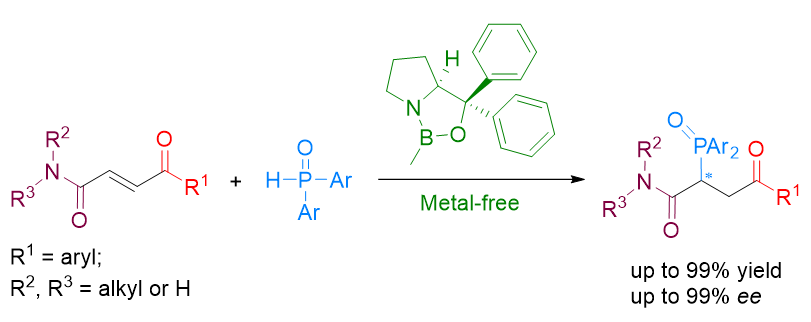| [1] |
Corey E. J. Angew. Chem., Int. Ed. 2002, 41, 1650.
|
| [2] |
(a) Hirao A.; Itsuno S.; Nakahama S.; Yamazaki N. J. Chem. Soc. Chem. Commun. 1981, 315.
|
|
(b) Itsuno S.; Ito K.; Hirao A.; Nakahama N. J. Org. Chem. 1984, 49, 555.
|
| [3] |
(a) Corey E. J.; Bakshi R. K.; Shibata S. J. Am. Chem. Soc. 1987, 109, 5551.
|
|
(b) Corey E. J.; Bakshi R. K.; Shibata S.; Chen C. P.; Singh V. K. J. Am. Chem. Soc. 1987, 109, 7925.
|
| [4] |
Liu D.; Canales E.; Corey E. J. J. Am. Chem. Soc. 2007, 129, 1498.
|
| [5] |
Corey E. J. Angew. Chem. Int. Ed. 2009, 48, 2100.
doi: 10.1002/anie.200805374
pmid: 19235825
|
| [6] |
(a) Corey E. J.; Loh T. P. J. Am. Chem. Soc. 1991, 113, 8966.
pmid: 17900126
|
|
(b) Corey E. J.; Shibata T.; Lee T. W. J. Am. Chem. Soc. 2002, 124, 3808.
pmid: 17900126
|
|
(c) Canales E.; Corey E. J. J. Am. Chem. Soc. 2007, 129, 12686.
pmid: 17900126
|
|
(d) Zhou G.; Corey E. J. J. Am. Chem. Soc. 2005, 127, 11958.
pmid: 17900126
|
| [7] |
(a) Zhu R.; Liao K.; Yu J.; Zhou J. Acta Chim. Sinica 2020, 78, 193 (in Chinese).
|
|
(朱仁义, 廖奎, 余金生, 周剑, 化学学报, 2020, 78, 193.)
doi: 10.6023/A20010002
|
|
(b) Novas B. T.; Waterman R. ChemCatChem 2022, 14, e202200988.
|
|
(c) Zhang Y.; Zhu S. Acta Chim. Sinica 2023, 81, 777 (in Chinese).
|
|
(张艳东, 朱守非, 化学学报, 2023, 81, 777.)
doi: 10.6023/A23040125
|
|
(d) Luo C.; Yin Y.; Jiang Z. Chin. J. Org. Chem. 2023, 43, 1963 (in Chinese).
|
|
(罗诚, 尹艳丽, 江智勇, 有机化学, 2023, 43, 1963.)
doi: 10.6023/cjoc202212024
|
|
(e) Zhang J.; Ni H.; Wu Q.; Yang J.; Zhang J. Chin. J. Org. Chem. 2022, 42, 3118 (in Chinese).
|
|
(张洁明, 倪航, 吴起, 杨俊锋, 张俊良, 有机化学, 2022, 42, 3118.)
doi: 10.6023/cjoc202208043
|
| [8] |
(a) Feng J.; Chen X.; Shi M.; Duan W. J. Am. Chem. Soc. 2010, 132, 5562.
|
|
(b) Lu Z.; Zhang H.; Yang Z.; Ding N.; Meng L.; Wang J. ACS Catal. 2019, 9, 1457.
|
|
(c) Yue W.; Xiao J.; Zhang S.; Yin L. Angew. Chem., Int. Ed. 2020, 59, 7057.
|
|
(d) Pérez J. M.; Postolache R.; Castineira Reis M.; Sinnema E. G.; Vargová D.; de Vries F.; Otten E.; Ge L.; Harutyunyan S. R. J. Am. Chem. Soc. 2021, 143, 20071.
|
|
(e) Yu X.; Lu L.; Zhang Z.; Shi D.; Xiao W. Org. Chem. Front. 2022, 10, 133.
|
|
(f) Sun G.; Xiao F.; Duan W. Chin. J. Org. Chem. 2020, 40, 61 (in Chinese).
|
|
(孙贵救, 肖繁花, 段伟良, 有机化学, 2020, 40, 61.)
doi: 10.6023/cjoc201905022
|
|
(g) Zhang F.; Luan Y.; Ye M. Chin. J. Org. Chem. 2021, 41, 3880 (in Chinese).
|
|
(张凤萍, 栾玉新, 叶萌春, 有机化学, 2021, 41, 3880.)
|
| [9] |
(a) Saito B.; Egami H.; Katsuki T. J. Am. Chem. Soc. 2007, 129, 1978.
pmid: 18567046
|
|
(b) Yang F.; Zhao D.; Lan J.; Xi P.; Yang L.; Xiang S.; You J. Angew. Chem., Int. Ed. 2008, 47, 5646.
doi: 10.1002/anie.200801766
pmid: 18567046
|
|
(c) Maiti R.; Yan J.; Yang X.; Mondal B.; Xu J.; Chai H.; Jin Z.; Chi Y. R. Angew. Chem., Int. Ed. 2021, 60, 26616.
pmid: 18567046
|
|
(d) Hu H.; Ren X.; He J.; Zhu L.; Fang S.; Su Z.; Wang T. Sci. China Chem. 2022, 65, 2500.
pmid: 18567046
|
|
(e) Guo F.; Chen J.; Huang Y. ACS Catal. 2021, 11, 6316.
pmid: 18567046
|
| [10] |
Qian J.; Zhao H.; Gao Q.; Chen L.; Shi Y.; Li J.; Guo Y.; Fan B. Org. Chem. Front. 2023, 10, 5672.
|
| [11] |
Shi Y.; Chen L.; Gao Q.; Li J.; Guo Y.; Fan B. Org. Lett. 2023, 25, 6495.
|
| [12] |
Chen L.; Wang G.; Nong X.; Shao W.; Li J.; Guo Y.; Fan B. Chem. Eur. J. 2024, 30, e202401017.
|
| [13] |
Lu G.; Xiao L.; Que Q.; Leng T.; Li J.; Guo Y.; Fan B. J. Org. Chem. 2024, 89, 7573.
|
 ), 樊保敏a,*(
), 樊保敏a,*( )
)
 ), Baomin Fana,*(
), Baomin Fana,*( )
)
